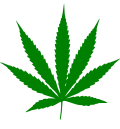Cannabis in Papua New Guinea
| Part of a series on |
| Cannabis |
|---|
 |
 Location of Papua New Guinea (dark green) | |
| Medicinal | Illegal |
|---|---|
| Recreational | Illegal |
Cannabis in Papua New Guinea is illegal, but the nation is a significant producer and consumer of cannabis. Cannabis is sometimes called spak brus in local parlance.
History
[edit]Cannabis is believed to have been introduced to PNG by Australian and American expatriates in the 1960s-1970s.[1] From them the habit spread to locals, and by the 1980s cannabis could be bought in the major cities.[2]
Agriculture
[edit]Though cannabis can be grown throughout PNG, it is largely grown in the mountainous highlands from 1400-2200m in elevation, particularly in the drier areas of the highlands where it is said to grow a more powerful product.[2]
Economy
[edit]Cannabis is the only illegal drug produced in significant amounts in PNG, and is the most popular illegal drug consumed there; it is largely grown in Eastern Highlands, Western Highlands, and Southern Highlands provinces, and from there transported to other sites in the country.[3][4] Cannabis is produced for domestic use, as well as for export (primarily to Australia), and per some reports cannabis has been bartered for weapons.[5]
Cannabis is a lucrative cash crop[6] in PNG, and is exported to Australia across the Torres Strait. 1990 reports state the "PNG Gold" was valued at AU$12,000 per kilogram.
References
[edit]- ^ Mark A. R. Kleiman; James E. Hawdon (12 January 2011). Encyclopedia of Drug Policy. SAGE Publications. pp. 630–. ISBN 978-1-4522-6628-2.
- ^ a b R. Michael Bourke; Tracy Harwood (August 2009). Food and Agriculture in Papua New Guinea. ANU E Press. pp. 227–. ISBN 978-1-921536-61-8.
- ^ Beno Boeha; John McFarlane (2000). Australia and Papua New Guinea: Crime and the Bilateral Relationship. Australian Defence Studies Centre, Australian Defence Force Academy. p. 88. ISBN 978-0-7317-0439-2.
- ^ United Nations: International Narcotics Control Board (1 February 2007). Report of the International Narcotics Control Board 2006. United Nations Publications. pp. 84–. ISBN 978-92-1-148218-8.[permanent dead link]
- ^ International Narcotics Control Board (2002). Report of the International Narcotics Control Board for 2001. United Nations Publications. pp. 80–. ISBN 978-92-1-148145-7.[permanent dead link]
- ^ John Connell (28 July 2005). Papua New Guinea: The Struggle for Development. Routledge. pp. 73–. ISBN 978-1-134-93832-2.
Further reading
[edit]- Thomson, Ben (7 November 2014). "Polaroids from Papua New Guinea's Weed-Growing Highlands". Vice.
- Halvaksz a, Jamon; Lipset, David (2006). "Another Kind of Gold: An Introduction to Marijuana in Papua New Guinea". Oceania. 76 (3, Marijuana in Papua New Guinea (Nov., 2006), pp. 209-219): 209–219. doi:10.1002/j.1834-4461.2006.tb03051.x. JSTOR 40332031.
- Chen; et al. "Societal and health aspects of psychoactive drug abuse in Papua New Guinea" (PDF). Pacific Health Dialog. 6 (1): 93–100.